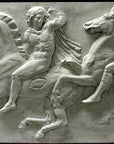42 Inches High x 68 Inches Wide
The Parthenon, a temple dedicated to the goddess Athena, is an astounding example of Classical Greek architecture and art. It was built by the architects Ictinus and Callicrates while the supervisor, and also the artistic director, for the project was the sculptor Phidias. Situated on the Acropolis in Athens, the Parthenon, at its prime, was a temple of white marble with countless colorful sculptures. Today, it is partially in ruins. The frieze that surrounded the cella, or the interior structure, still exists, but is divided among many museums around the world. The Acropolis Museum and the British Museum hold the majority of the 115 blocks, which formed the 160 meter- (or 525 foot-) long frieze. The narrative is about the procession that took place on the final day of the festival that honored Athena, the Great Panathenaia.
In this panel, two horsemen ride galloping horses in the procession. The man on the left turns back towards the other rider. With his left hand above his head, he might be gesturing to his companion. Holes in his hair and in the horses' heads and necks were likely meant for a metal wreath and metal reins, respectively.
Artist: Unknown
Museum: British Museum, London
Origin: The Parthenon - Western Frieze, Athens
Time Period: Ancient Greek, 447-432 B.C.E.
1911 Catalog ID # - 7000 Slab II
Sources:
Choremi, A. “The Parthenon Frieze. Block W II.” The Parthenon Frieze. English translation by M. Caskey. Ministry of Culture – Acropolis Restoration Service – First Ephorate of Prehistoric and Classical Antiquities – Department of Information and Education, and National Documentation Centre – National Hellenic Research Foundation, 2009, http://repository.parthenonfrieze.gr/frieze/handle/10442/wii.
“The Frieze.” Acropolis Museum, http://www.theacropolismuseum.gr/en/content/frieze-0.
Hadziaslani, C. and I. Kaimara. “About Parthenon.” The Parthenon Frieze. English translation by M. Caskey. Ministry of Culture – Acropolis Restoration Service – First Ephorate of Prehistoric and Classical Antiquities – Department of Information and Education, and National Documentation Centre – National Hellenic Research Foundation, 2009, http://repository.parthenonfrieze.gr/frieze/aboutParthenon.jsp.
“Parthenon.” Wikipedia, https://en.wikipedia.org/wiki/Parthenon#Architecture.
“The Parthenon Sculptures.” Museum number 1816,0610.47. The British Museum, http://www.britishmuseum.org/research/collection_online/collection_object_details.aspx?objectId=461665&partId=1&searchText=parthenon+ii&page=1.
42 Inches High x 68 Inches Wide
The Parthenon, a temple dedicated to the goddess Athena, is an astounding example of Classical Greek architecture and art. It was built by the architects Ictinus and Callicrates while the supervisor, and also the artistic director, for the project was the sculptor Phidias. Situated on the Acropolis in Athens, the Parthenon, at its prime, was a temple of white marble with countless colorful sculptures. Today, it is partially in ruins. The frieze that surrounded the cella, or the interior structure, still exists, but is divided among many museums around the world. The Acropolis Museum and the British Museum hold the majority of



